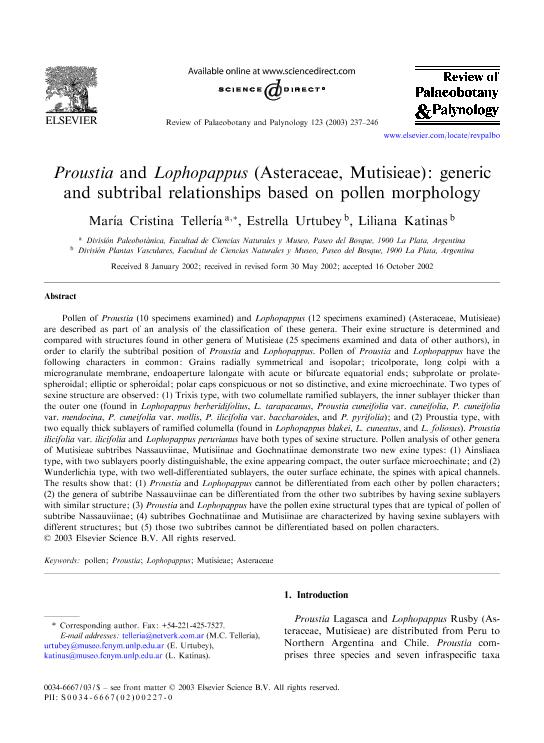Mostrar el registro sencillo del ítem
dc.contributor.author
Tellería, María Cristina

dc.contributor.author
Urtubey, Estrella

dc.contributor.author
Katinas, Liliana

dc.date.available
2021-12-17T17:46:11Z
dc.date.issued
2003-03
dc.identifier.citation
Tellería, María Cristina; Urtubey, Estrella; Katinas, Liliana; Proustia and Lophopappus (Asteraceae, Mutisieae): Generic and subtribal relationships based on pollen morphology; Elsevier Science; Review of Palaeobotany and Palynology; 123; 3-4; 3-2003; 237-246
dc.identifier.issn
0034-6667
dc.identifier.uri
http://hdl.handle.net/11336/148961
dc.description.abstract
Pollen of Proustia (10 specimens examined) and Lophopappus (12 specimens examined) (Asteraceae, Mutisieae) are described as part of an analysis of the classification of these genera. Their exine structure is determined and compared with structures found in other genera of Mutisieae (25 specimens examined and data of other authors), in order to clarify the subtribal position of Proustia and Lophopappus. Pollen of Proustia and Lophopappus have the following characters in common: Grains radially symmetrical and isopolar; tricolporate, long colpi with a microgranulate membrane, endoaperture lalongate with acute or bifurcate equatorial ends; subprolate or prolate-spheroidal; elliptic or spheroidal; polar caps conspicuous or not so distinctive, and exine microechinate. Two types of sexine structure are observed: (1) Trixis type, with two columellate ramified sublayers, the inner sublayer thicker than the outer one (found in Lophopappus berberidifolius, L. tarapacanus, Proustia cuneifolia var. cuneifolia, P. cuneifolia var. mendocina, P. cuneifolia var. mollis, P. ilicifolia var. baccharoides, and P. pyrifolia); and (2) Proustia type, with two equally thick sublayers of ramified columella (found in Lophopappus blakei, L. cuneatus, and L. foliosus). Proustia ilicifolia var. ilicifolia and Lophopappus peruvianus have both types of sexine structure. Pollen analysis of other genera of Mutisieae subtribes Nassauviinae, Mutisiinae and Gochnatiinae demonstrate two new exine types: (1) Ainsliaea type, with two sublayers poorly distinguishable, the exine appearing compact, the outer surface microechinate; and (2) Wunderlichia type, with two well-differentiated sublayers, the outer surface echinate, the spines with apical channels. The results show that: (1) Proustia and Lophopappus cannot be differentiated from each other by pollen characters; (2) the genera of subtribe Nassauviinae can be differentiated from the other two subtribes by having sexine sublayers with similar structure; (3) Proustia and Lophopappus have the pollen exine structural types that are typical of pollen of subtribe Nassauviinae; (4) subtribes Gochnatiinae and Mutisiinae are characterized by having sexine sublayers with different structures; but (5) those two subtribes cannot be differentiated based on pollen characters.
dc.format
application/pdf
dc.language.iso
eng
dc.publisher
Elsevier Science

dc.rights
info:eu-repo/semantics/openAccess
dc.rights.uri
https://creativecommons.org/licenses/by-nc-sa/2.5/ar/
dc.subject
ASTERACEAE
dc.subject
LOPHOPAPPUS
dc.subject
MUTISIEAE
dc.subject
POLLEN
dc.subject
PROUSTIA
dc.subject.classification
Ciencias de las Plantas, Botánica

dc.subject.classification
Ciencias Biológicas

dc.subject.classification
CIENCIAS NATURALES Y EXACTAS

dc.title
Proustia and Lophopappus (Asteraceae, Mutisieae): Generic and subtribal relationships based on pollen morphology
dc.type
info:eu-repo/semantics/article
dc.type
info:ar-repo/semantics/artículo
dc.type
info:eu-repo/semantics/publishedVersion
dc.date.updated
2021-12-03T19:35:14Z
dc.journal.volume
123
dc.journal.number
3-4
dc.journal.pagination
237-246
dc.journal.pais
Países Bajos

dc.journal.ciudad
Amsterdam
dc.description.fil
Fil: Tellería, María Cristina. Universidad Nacional de La Plata. Facultad de Ciencias Naturales y Museo. Área Paleobotánica; Argentina. Consejo Nacional de Investigaciones Científicas y Técnicas. Centro Científico Tecnológico Conicet - La Plata; Argentina
dc.description.fil
Fil: Urtubey, Estrella. Universidad Nacional de La Plata. Facultad de Ciencias Naturales y Museo. División de Plantas Vasculares; Argentina. Consejo Nacional de Investigaciones Científicas y Técnicas. Centro Científico Tecnológico Conicet - La Plata; Argentina
dc.description.fil
Fil: Katinas, Liliana. Universidad Nacional de La Plata. Facultad de Ciencias Naturales y Museo. División de Plantas Vasculares; Argentina. Consejo Nacional de Investigaciones Científicas y Técnicas. Centro Científico Tecnológico Conicet - La Plata; Argentina
dc.journal.title
Review of Palaeobotany and Palynology

dc.relation.alternativeid
info:eu-repo/semantics/altIdentifier/url/https://www.sciencedirect.com/science/article/pii/S0034666702002270
dc.relation.alternativeid
info:eu-repo/semantics/altIdentifier/doi/http://dx.doi.org/10.1016/s0034-6667(02)00227-0
Archivos asociados
